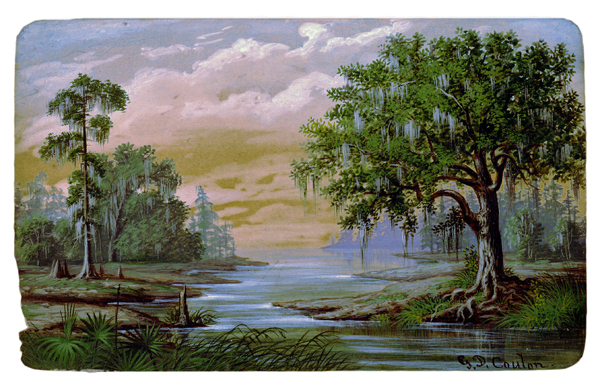George David Coulon and Family
The works of Louisiana artist George David Coulon are known for the meticulous detail and the jewel-like quality of his portraits and landscapes, most of which were painted between 1839 and 1902.

Courtesy of Roger H. Ogden Collection
Louisiana Sunrise. Coulon, George David (Artist)
A native of France, George David Coulon made a substantial contribution to New Orleans as an artist, teacher, and restorer of portraits. Painted between 1839 and 1902, Coulon’s work was known for the meticulous detail and the jewel-like quality of his portraits and landscapes. Art was a family affair for Coulon, who was sometimes assisted by his wife, son, and daughter—all artists in their own right. A founding member of the Southern Art Union and its successor the Artists’ Association of New Orleans, Coulon made the first known attempt to document New Orleans’ artistic heritage, brief notes that are in the collection of the Louisiana State Museum.
Early Life
George David Coulon was born in Seloncourt, France, on November 14, 1822. At age ten, he immigrated to Louisiana with his mother, father, and siblings. As a child, Coulon made “drawings and colored them with indigo, the juice of herbs and berries.” Though Coulon’s father wanted him to learn watchmaking, he eventually allowed George to pursue his artistic interests. Young George studied art in New Orleans with Toussaint-François Bigot, François Fleischbein, and Antoine Mondelli, as well as Julien Hudson, a free man of color.
In 1839, Coulon assisted muralist Léon Pomarède, painting Raphael’s Transfiguration in St. Patrick’s Church on Camp Street, in New Orleans. He also assisted in painting a ceiling fresco in the Cabildo’s Old Criminal Court. In 1841 Coulon completed his first portrait; his second, Young Boy Holding a Rose, is in the collection of the Louisiana State Museum. In 1845, Coulon began restoring aged and damaged paintings. From 1851 to 1865, he also taught drawing and painting at informal schools for girls and young women, after which he gave private lessons. His students included John Kingston, Marie Seebold [Molinary], Marie de Jastram, Eloise Walker Duffy, Adine Reed, and Carrie Trost.
Coulon received commissions from charitable and religious institutions, including an 1848 nativity scene. After 1853, Coulon painted portraits from photographs, some times working with photographer John Hawley Clarke to enhance black-and-white photographs with color. Subsequently, his paintings became more photographic in their appearance. From about 1885 through 1897, Coulon painted portraits of seven Louisiana Supreme Court justices, including Joshua Lewis, Pierre Derbigny, François-Xavier Martin, and Frank Chrétien. Opera singer Adelina Patti (1843–1919) was also among his patrons.
The Coulon Family
Coulon’s success as an artist was due, at least in part, to the contributions of his wife and children. In 1850 Coulon married artist Marie-Paoline Casbergue (called Paoline), a New Orleans native born on June 14, 1831. In 1867, she exhibited at Peck’s Store on Canal Street, and received an award for the best pastel drawing at the Grand State Park. Though few of Paoline Coulon’s works survive, her signed works were primarily animal studies, particularly still lifes of birds and other game. She subjugated her artistic work to her familial responsibilities, but she contributed to her husband’s commissioned portraits, particularly in the detail work of the sitter’s accoutrements.
Of George and Paoline’s five children, only two lived past infancy: George Joseph Amedé Coulon and Mary Elizabeth Emma Coulon, both artists. Born in New Orleans on July 28, 1854, George A. Coulon was known for his portraits, landscapes, animal studies, still lifes, and photographs. In 1894, he created a twenty-eight-panel series of pastel and oil paintings. The subjects of this series—fruit, fish, and fowl—were particularly appropriate for the setting: Fabacher’s Restaurant in the French Quarter. He also attempted a fifteen-part periodical titled 350 Miles in a Skiff Through the Louisiana Swamps, the first (and only) volume of which was published in 1888. Coulon was the first person to take a handheld camera into the Atchafalaya Basin to document the customs of the trappers and lumbermen who lived and worked there. The resultant publication was a single artist’s effort to provide text, sketches, and photographs. After the inaugural issue, however, his endeavor met prompt defeat from an unnamed rival artist, who disposed of the manuscript and artwork that Coulon had entrusted to him.
Emma Coulon, as she was known, was born in New Orleans on May 11, 1859, and died in the city on April 2, 1928. Her work included skillfully constructed portraits, rural scenes, still lifes, and illustrations for sheet music. Her portrait of her father is now in the collection of the Louisiana State Museum. After her father’s death, she announced her intention to focus on portrait painting.
Conclusion
Toward the end of his life, George Davis Coulon provided valuable documentation of the New Orleans art world. At the request of artist Bror Andres Wikström, Coulon wrote short biographical notes about New Orleans artists that are now pivotal to the study of Louisiana art. Written when Coulon was seventy-nine, these efforts mark the first attempt to record the history of Louisiana art. In his autobiographical notes, Coulon indicated that, during his career, he had made more than one hundred portraits based on death masks (a cast made of a person’s face after their death). Coulon died on February 28, 1904, at the age of eighty-one. Paoline died in New Orleans on July 3, 1914, at the age of eighty-three.
